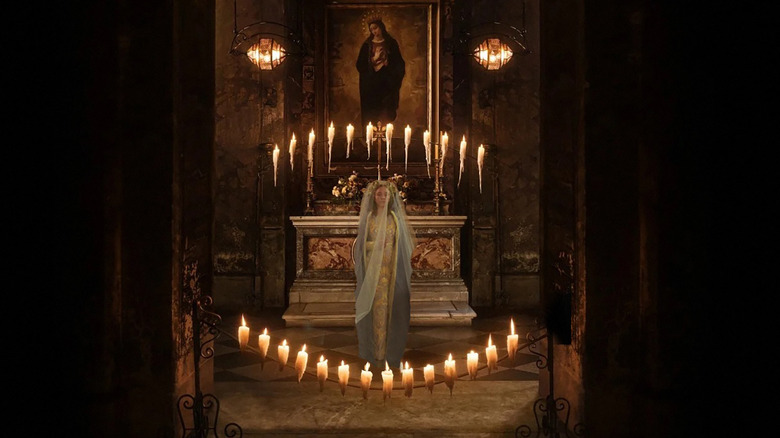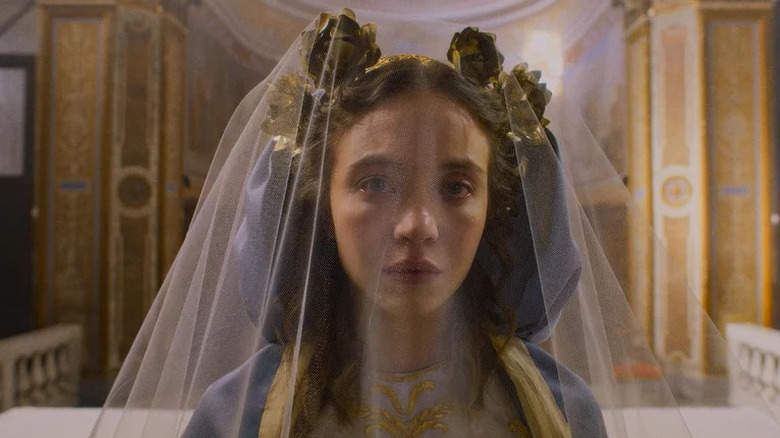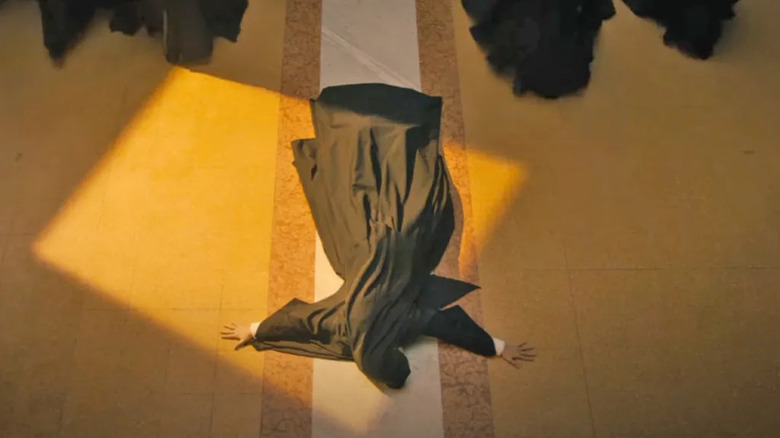Everything Immaculate And The First Omen Have In Common (Besides Evil Pregnancies)
Major spoilers for "Immaculate" and "The First Omen" follow.
There's a history of movies with oddly similar premises premiering within months of each other. "Armageddon" and "Deep Impact" both hit theaters in the summer of 1998, much like the Earth-shattering meteors featured in both films. The year before, there was "Volcano" and "Dante's Peak." 2022 gave us not one but two "Pinocchio" movies (with a clean victory for Guillermo del Toro's version).
This past month saw the latest case of dueling movies: "Immaculate," released on March 22, 2024, and "The First Omen," released on April 5, 2024. Both films are about American nuns who fly off to a new life in Italy. Once they arrive at the convent, the young sister discovers a sinister conspiracy at work and becomes pregnant via an unnatural conception. Unlike Mother Mary, the fruits of their wombs are not blessed.
"Immaculate," starring new starlet Sydney Sweeney as Sister Cecilia and directed by Michael Mohan, is an original film (though indebted to "Rosemary's Baby"). "The First Omen" (directed by Arkasha Stevenson) is a prequel to 1976's "The Omen" about the demonic Damien Thorn, the child Antichrist. Ever since a shockingly good trailer dropped this January, hopes were raised for what seemed like a mere cash grab — these prayers were answered (You can read /Film's positive "The First Omen" review here).
Are these twin movies about unholy pregnancies identical or fraternal, and which is more successful on its own terms?
Immaculate conceptions
In "Immaculate" (which is 30 minutes shorter than the 2-hour-long "The First Omen"), Cecilia and the audience discover she is pregnant early on. The mystery is more about what the priests' and nuns' intentions for her are. In "The First Omen," Margaret (Nell Tiger Free) only realizes she's pregnant in the third act (though an earlier scene where she blacked out, mixed with hints of her backstory, might have the viewer guessing something's up) — because carrying the spawn of Satan results in a shortened pregnancy.
Both nuns' pregnancies are orchestrated by a conspiracy within the church, but to different ends. "The First Omen" follows the backstory of the original "Omen" — Margaret's superiors intend her to give birth to the Antichrist and the father is a demonic jackal.
In "Immaculate," it's not a natural birth either, but not a supernatural one either. Father Tedeschi (Álvaro Morte), a biologist in a previous life, scraped DNA off one of the nails that bound Jesus to the crucifix and believes a clone of Christ (born from an embryo implanted in Cecilia's womb) will lead to the Second Coming. In both films, the pregnancy is just the latest effort after previous births resulted in deformed abominations.
"The First Omen" has a more sustained mystery, including a red herring. Margaret befriends Carlita (Nicole Sorace), an orphan from one of the previous attempts at birthing Damien. Carlita appears to be being reared as the mother of the Antichrist, before the third act twist that Margaret herself is of Satanic heritage too (and can bear her father's destroyer born of incest). Since "The First Omen" is a prequel, though, its mystery has a forgone conclusion; the last 5-10 minutes feel like checklist clearing.
An Omen of horror
"Immaculate" is the leaner film; it showcases Sweeney's talent first and foremost, with an isolated setting (Cecilia is forbidden to leave the convent and her goal is to escape) and a cast that orbits her. There's nary a scene where the camera doesn't linger on her haunted, doe-eyed face. Cecilia giving birth standing up is framed via an unbroken close-up of her bloodied, screaming face (nailed by Sweeney on take one). The film keeps the most graphic details out of sight so the audience remains focused on how it's affecting Cecilia. Without Sydney Sweeney, there is no "Immaculate."
"The First Omen" has a larger scope. The film includes scenes throughout Rome, not just the Vizzardeli Orphanage, and more supporting players. Ralph Ineson plays Margaret's ally Father Brennan, who (when he was played by Patrick Troughton in the original "Omen") warned Robert Thorn (Gregory Peck) of his adopted son's true nature.
"Immaculate" grounds its horror by putting you in Cecilia's shoes, whereas "The First Omen" offers a third-person view, emphasizing the body horror innate to pregnancy. Early in the movie, Margaret sees a woman giving birth and instead of a baby's head emerging from her vagina, it's a demonic hand (shot nearly straight on, which almost got the movie an NC-17 rating). While "Immaculate" purposefully keeps the messy business of birth out of the camera's view (minus Cecilia biting her own umbilical cord), "The First Omen" shows Damien's birth by C-section in nauseating detail (ending with a perfect needle drop of Jerry Goldsmith's "Omen" theme, "Ave Satani").
If surgery makes your skin crawl like it does mine, this scene will have your eyes looking anywhere but the screen. When "Immaculate" begins its final horrifying close-up, you can't look away.
Nunsploitation goes pro-choice
What are these movies actually trying to say? Basically the same thing. They're about the patriarchal structure of the Church which values women only as obedient servants, down to making them carry pregnancies they don't want.
The politics of "Immaculate" aren't subtle; a woman forced into an unwanted pregnancy is baked into the premise. Masked inquisitors remove Sister Gwen's (Benedetta Porcaroli) tongue while Tedeschi brands Cecilia's feet to keep her in place. The brutal ending concludes with Cecilia smashing the unholy spawn she's birthed with a rock; motherhood is a choice, not a duty.
There's a visual motif of women being bound in "The First Omen" — close-ups of hands tied by leather straps during childbirth, Margaret being forced into a black hood while the Beast rapes her, Sister Luz Valez (Maria Caballero) being fitted with a binding, uncomfortable habit when she takes the veil. Indeed, "The First Omen" takes the prize here for a more developed thesis, while reframing the original film in the process.
"The Omen" suggested that Satanist infiltrators within the Church orchestrated Damien's birth. "The First Omen" does something different, revealing that the conspirators are true men and women of God who feel the Church losing its grip on people. Student protests throughout Rome recur during the movie, emphasizing a younger generation embracing secularism. So, as Father Brennan explains, the Vizzardeli sect wants to birth the Antichrist to regain control; if Damien ravages the Earth, people will have no choice but to turn back to God. In "Immaculate," the Church is trying to save the world, albeit to their own misogynistic designs. In "The First Omen," The Church would rather burn the world than relinquish control of it.
Both "Immaculate" and "The First Omen" are playing now in theaters.



